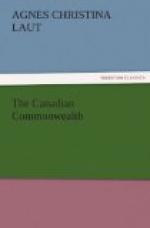From Canada to the United States, exports increased from $95,000,000 in 1910 to $120,000,000 in 1913, not because Canada’s producing power is so much smaller than her buying power, but because she is growing so fast that she consumes much of what she produces. To put it another way, of all Canada exports, the United States takes four-fifths of the coal, nine-tenths of the copper, four-fifths of the nickel, ten-elevenths of the gold, two-fifths of the silver, four-fifths of other minerals, one-third of the fish, one-third of the lumber, one-fourth of the animals and meat, one-tenth of the grain. It need not be told here that the other portions of Canada’s farm, mine and lumber exports go almost entirely to Great Britain.
II
It has been estimated that half a billion of American capital is invested in Canada. A moment’s thought reveals how ridiculously below the mark are these figures. Between 1900 and 1911 by actual count there entered Canada 650,719 American settlers. Averaging up one year with another by actual estimate of settlers’ possessions at point of entry, these settlers were possessed of fifteen hundred dollars each in cash. This represents almost a billion, and almost as many more American settlers have entered Canada since 1911. This represents not the investments of the capital class but of small savings. It takes no account of the nickel mines, the copper mines, the smelters, the silver mines, the coal lands, the timber limits, the fisheries, the vast holdings of agricultural lands in the West held for speculative purposes—for all of which spot cash was paid down in large proportion.
The largest steel plant in the East, the largest coal areas in the West, the only nickel mines in America, three-quarters of all the copper and gold reduction works of the West are financed by American capital. To be more explicit, when the MacKenzie-Mann interests bought one large coal area in British Columbia, the Hill interests of St. Paul bought the other large coal area. This does not mean there are not large coal areas owned by Canadian capital. There are—colossal areas; but for every big area being worked by Canadian capital there are two such being worked by American.
Before a single Canadian railroad had wakened up to the fact there were any mines in East and West Kootenay and the Slocan, American lines had pushed up little narrow-gauge lines to feed the copper and gold ores into Butte and Helena smelters. By the time Canadian and British capital came on the scene in Kootenay the cream had been skimmed from the profits, and the mines had reached the wildcat stage of beautifully gilded and engraved stock certificates taking the place of real profits—of almost worth-nothing shares in worthless holes in the ground selling on a face value of a next-door profit-yielding neighbor. The American is without a peer as pioneer on land,




